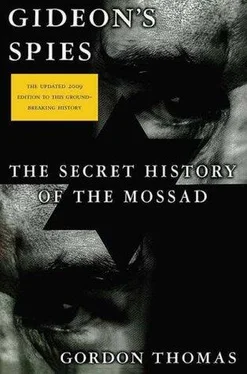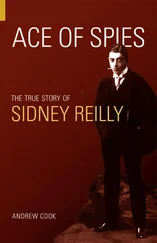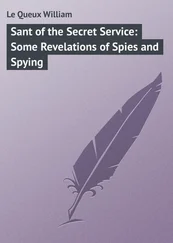Gordon Thomas - Gideon's Spies
Здесь есть возможность читать онлайн «Gordon Thomas - Gideon's Spies» весь текст электронной книги совершенно бесплатно (целиком полную версию без сокращений). В некоторых случаях можно слушать аудио, скачать через торрент в формате fb2 и присутствует краткое содержание. Город: New York, Год выпуска: 2009, ISBN: 2009, Издательство: Thomas Dunne Books, Жанр: История, на английском языке. Описание произведения, (предисловие) а так же отзывы посетителей доступны на портале библиотеки ЛибКат.
- Название:Gideon's Spies
- Автор:
- Издательство:Thomas Dunne Books
- Жанр:
- Год:2009
- Город:New York
- ISBN:978-0-312-53901-6
- Рейтинг книги:4 / 5. Голосов: 1
-
Избранное:Добавить в избранное
- Отзывы:
-
Ваша оценка:
- 80
- 1
- 2
- 3
- 4
- 5
Gideon's Spies: краткое содержание, описание и аннотация
Предлагаем к чтению аннотацию, описание, краткое содержание или предисловие (зависит от того, что написал сам автор книги «Gideon's Spies»). Если вы не нашли необходимую информацию о книге — напишите в комментариях, мы постараемся отыскать её.
Gideon’s Spies
Gideon's Spies — читать онлайн бесплатно полную книгу (весь текст) целиком
Ниже представлен текст книги, разбитый по страницам. Система сохранения места последней прочитанной страницы, позволяет с удобством читать онлайн бесплатно книгу «Gideon's Spies», без необходимости каждый раз заново искать на чём Вы остановились. Поставьте закладку, и сможете в любой момент перейти на страницу, на которой закончили чтение.
Интервал:
Закладка:
At two thirty on the afternoon of Thursday, July 17, 2003, Detective Chief Inspector Alan Young sat down before his secure computer and began to create a highly restricted file. Across the top of his screen he typed a code name: Operation Mason . Beneath it he added: Not for Release. Police Operational Information . Below that he added the figures: 14.30 and 17.07.03 , indicating the file had been opened at two thirty p.m. on Thursday, July 17, 2003. Young’s file had been created after a morning of tense discussions in various government offices in Whitehall. In his pastel-painted office suite in the Joint Intelligence Committee location, John Scarlett, its chairman for the past two years, had taken his share of the calls. Scarlett had a well-attuned nose for trouble and must have sensed Dr. Kelly’s responses before the parliamentary committee and the continuing government row with the BBC were becoming a serious problem.
Scarlett had played a key part in producing the controversial dossier. In doing so, he had discarded the carefully judged input of Dr. Kelly in the early drafts. The original intelligence had come from MI6 and was approved by its then director general Sir Richard Dearlove before it had electronically made its way through the intelligence community, passing across the desk of the Defence Intelligence staff. None of them had supported Dr. Kelly’s original assertion that Saddam had no weapons of mass destruction. He had become the lonely voice who had finally decided to speak to the BBC. What else could Kelly do, would he do? And say? These were the questions troubling Scarlett.
Dr. Kelly had received phone calls his wife, Janice Kelly, was certain came from MI6. She remembered her husband taking some calls behind the closed door of his study, fitted out with seven laptops and his high-security computer on his desks installed by MI5 along with his direct high-security line to Porton Down. It later emerged that when he had left the house, he received two more calls on his cell phone as he walked. The identity of the callers would never be traced.
Dr. Kelly’s body was found in a woodland the next day. Two separate police teams gave different locations for where and how his corpse was positioned. By then, officers from the MI5 Technical Assessment Centre had removed from Dr. Kelly’s study all his electronic equipment. The data on them would remain secret. However, three eminent British medical specialists took the highly unusual step of publicly saying Dr. Kelly could never have committed suicide based on the published forensic details. Their conclusions raised disturbing questions. What could account for the lack of blood from the small wrist slash? What part, if any, had the small number of painkillers he had swallowed played? Could the answers be linked to Dr. Kelly’s own prediction made to a friend that he “would not be surprised if my body isn’t one day found in the woods”?
There were a number of reasons for Mossad to pay more than a passing interest to those words. Dr. Kelly had triggered an unprecedented crisis for the Blair government after publicly questioning the validity of the now notorious “sexed-up” dossier. “Preposterous though it seems to outsiders, taking out a troublemaker is not unknown in the dark side of secret intelligence. Mossad does it with its kidon. Other services have their hit men available, contract killers who cannot be traced,” claimed Ari Ben-Menashe (to the author).
There were persistent reports that Dr. Kelly had been targeted by Saddam Hussein’s hit squads while he had been in Iraq probing the country’s arsenal. His own MI5 contacts had warned him he was at risk. There were other possible threats to his safety. His work in unscrambling the Soviet Union’s secret biological arsenal had angered many of its scientists when he refused to help them come to Britain to work. MI5 had warned Dr. Kelly that some of the scientists had maintained close contacts with the Russian Foreign Intelligence Service, which currently had thirty agents working out of the Russian Embassy. Dr. Kelly had been provided with a list of all the number plates of their cars. Only a week before his death, a Land Rover—bearing the diplomatic number plate prefix 248D, assigned to all Russian diplomatic vehicles—had been spotted less than twenty miles from Southmoor, the village where Dr. Kelly lived.
Meir Dagan had asked Nathan to prepare a report on the scientist’s death. The London Station chief updated himself on the background to Dr. Kelly’s death after he had been found on Harrowdown Hill, a beauty spot near his home. The technicians at the Tactical Assessment Center had deconstructed the computer disks recovered from Dr. Kelly’s study, and calls to and from his cell phone found on his body had been analyzed. While most dealt with his daily workload at the Ministry of Defense and Porton Down, personal details had also emerged. They included two job offers he was considering to work in the private sector in America.
One offer was from the Washington-based company, Hadron Advanced Biosystems. It was run by a Soviet defector, Kamovtjan Alibekov, who had been the top scientist in that country’s biowarfare program and the inventor of the world’s most powerful genetically engineered anthrax. He had found a home in America’s biodefense industry and changed his name to Ken Alibek. His company had close ties to the Pentagon and the CIA and described itself as “specializing in the development of technical solutions for the U.S. intelligence community.” The other company was Regman Biotechnologies, one that Dr. Kelly had helped to set up in Britain. At the time of his death, the company had a contract with the U.S. Navy to “develop a diagnostic and therapeutic treatment for anthrax.” It stated its prime function was to “research powerful alternatives to antibiotics.” Both companies had offered Dr. Kelly remuneration double his present salary, sufficient to pay for private medical treatment that Janice urgently needed and for which there was a lengthy waiting list on Britain’s National Health Service.
Nicholas Gardiner, the Oxfordshire coroner, concluded Dr. Kelly committed suicide by cutting his left wrist with a blunt penknife he used as a gardening tool. He had also ingested twenty-eight coproxamol tablets, a painkiller for arthritis. Dr. Kelly did not suffer from the condition. They would have been hard to swallow without water or crunching them with his teeth. A bizarre twist came when, an hour after his body was found, Dr. Kelly’s dental records went missing from the local surgery. His dentist reported this to the police. Two days later the records reappeared in the surgery. Dr. Nicholas Hunt, the pathologist who carried out the autopsy, was sufficiently alarmed to ask the police to conduct a DNA test to “make sure the body was really Dr. Kelly’s.” The pathologist noted that there were “several superficial scratches on the wrist and one deep wound that had severed the ulnar artery but not the radial artery.” He concluded this had led to a fatal hemorrhage.
The three experienced medical specialists, who had already questioned whether Dr. Kelly had committed suicide, again challenged the conclusion: Dr. David Halpin, a consultant in trauma injuries; Dr. Stephen Frost, a radiologist; and Dr. Martin Birstingi, a vascular surgeon, all said that in their combined clinical experience—numbering some fifty years—they had never come across a case where somebody had died from cutting their ulnar artery. “To die from hemorrhage Dr. Kelly would have had to lose about five pints of blood,” stated Dr. Halpin. Dr. Frost said, “It is unlikely from the stated injury Dr. Kelly would have lost more than a pint of blood.” In Dr. Berstingi’s opinion, “When the ulnar artery is cut, there is a rapid fall in blood pressure and after a few further minutes the artery stops bleeding.” None of these experts were asked to testify at the inquest.
Читать дальшеИнтервал:
Закладка:
Похожие книги на «Gideon's Spies»
Представляем Вашему вниманию похожие книги на «Gideon's Spies» списком для выбора. Мы отобрали схожую по названию и смыслу литературу в надежде предоставить читателям больше вариантов отыскать новые, интересные, ещё непрочитанные произведения.
Обсуждение, отзывы о книге «Gideon's Spies» и просто собственные мнения читателей. Оставьте ваши комментарии, напишите, что Вы думаете о произведении, его смысле или главных героях. Укажите что конкретно понравилось, а что нет, и почему Вы так считаете.












